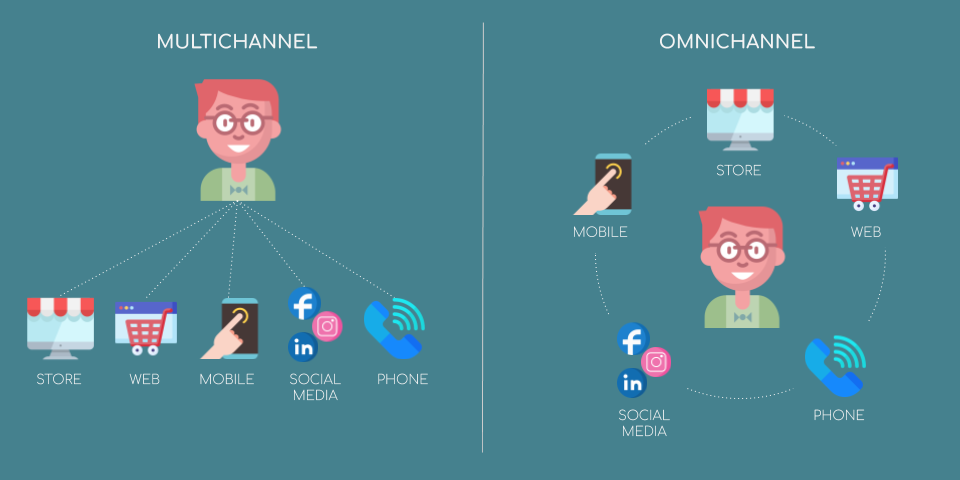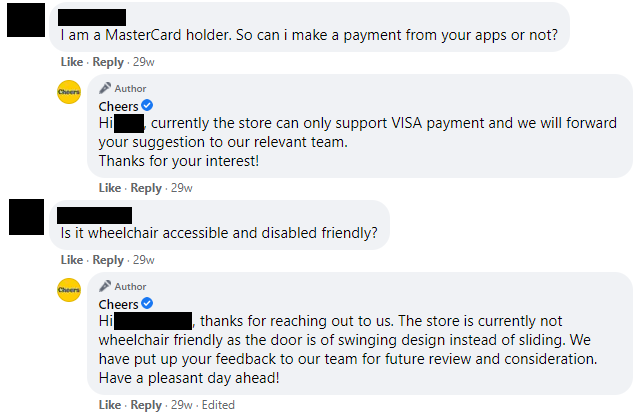[et_pb_section fb_built="1" _builder_version="4.16" global_colors_info="{}"][et_pb_row _builder_version="4.16" background_size="initial" background_position="top_left" background_repeat="repeat" global_colors_info="{}"][et_pb_column type="4_4" _builder_version="4.16" custom_padding="|||" global_colors_info="{}" custom_padding__hover="|||"][et_pb_text _builder_version="4.23.1" background_size="initial" background_position="top_left" background_repeat="repeat" global_colors_info="{}"]
Omnichannel user experience is a series we have been diving into, more specifically, the importance of it and how to create an omnichannel user experience. With the rapid growth of digital products and services, it's pertinent to take a new look at what digital solutions should be like at this time.
It's become necessary for many businesses to maintain a digital presence in order to survive, and to establish an omnichannel experience to thrive. The expectations of users are rising, growing with the revolution of technology around us. In the past, we would have had to drive out to the DVD store to get a movie but now, it's at the touch of our fingertips.
I can't stress the importance of omnichannel user experience enough, in fact, we have an article focusing purely on the importance of omnichannel user experience. I urge you to give it a read, it's a light read that gives you a good idea of what an omnichannel user experience is and why it's so important: The Importance of Omnichannel User Experience

In our article series for omnichannel user experience, we looked into the 5 key components of an omnichannel user experience:
- Consistent: To provide a consistent, comprehensive, familiar experience across all channels
- Optimized: Individual channel experiences that are optimized for each particular device, adhering to each channels’ constraints and contexts of use
- Seamless: To create effortless channel transitions, helping customers pick up right where they left off when they choose to switch from one channel to another
- Orchestrated: Guiding customers through their journey with the right interactions and timely messages that are personalized
- Collaborative: Empowering customers to take advantage of multiple channels at the same time, enriching the customer journey in improving the overall user experience
Amazon's Omnichannel User Experience: A Case Study
After writing several articles on how to create an omnichannel user experience that is consistent, optimized, seamless, and orchestrated, I thought, what better way to finish off this series than to look at an exemplary case study.
Amazon is a multinational technology company and is the largest internet company in the world by revenue. Amazon is the largest online marketplace, AI assistant provider, live-streaming platform, and cloud computing platform. Their services include Amazon.com, Amazon Alexa, Amazon Appstore, Amazon Music, Amazon Prime, Amazon Web Services (AWS) and Amazon Go.
Amazon's list of offerings is impressive and the key is their focus on users. Forbes has famously said, “Amazon has earned our trust by delivering the products we want, on time, intact, in the same branded brown boxes—consistently.”
In order to meet the demands of their users, they have nurtured and integrated an omnichannel approach to all their products and services. Using data, Amazon creates a personalized and responsive interaction across every channel.
Furthermore, all their channels are fully integrated, going beyond inventory and central fulfilment. Customer data is connected and they are able to fulfil the customer's demands in any channel that the customer wants to use.
Ordering groceries just by speaking
Users at home can order groceries just by speaking to Alexa, adding the grocery items to their cart from Amazon Fresh, Prime Now or Whole Foods.
There is no need to reach for their phone or laptop or to even write it down on their shopping list. Even if Alexa isn't able to locate an item, there is a reminder that is automatically added to the bottom of the cart with a search link.
Once the user wants to checkout, all they need to do is go to Amazon.com or their Amazon app and proceed to checkout. There isn't even a need to enter any shipping information or payment details because everything is saved on their account. All the user has to do is check that the details are correct, confirm the order and their groceries are on the way.
This scenario alone exhibits the 5 key components of an omnichannel user experience.
Customers have a consistent and familiar experience across all of Amazon's channels, users' intrinsically know that each interaction is unmistakably Amazon in its delivery and smoothness of operation.
Each individual channel has been optimized for the particular device, the user is able to easily speak to Alexa and the device responds to users, carrying out the intended tasks requested by the user.
Users can seamlessly continue on their user journey, they can also pick up their phone to check their Amazon app, effortlessly transitioning channels to check on the orders if they wish to do so.
Behind the scenes, the backend system is integrated so well that the user journey is orchestrated in a way to guide users with timely interactions that are personalized.
On top of all of that, it's a collaborative design where the user is able to take advantage of multiple channels at the same time if they want. The channels and services are integrated harmoniously, giving users a unified user experience. There's isn't a separation between their e-commerce channel and the virtual assistant, but instead, they work in collaboration with one another.
An effective and properly designed omnichannel ecosystem results in an exceptional user experience, and Amazon has done this by understanding and researching its users and user journeys and providing innovative technology to exceed their expectations.
Walking into a store, picking up what you want and Go
Amazon has created an omnichannel user experience unlike any other by fusing the channels of brick and mortar with the smartphone, and this isn't just paying using your e-wallet at the cashier.
Imagine walking into a store, picking up whatever you want and not having to pay at the cashier, you just walk out and whatever you have picked up is charged to your account, just like that!
There is no need to wait in line behind a customer buying a week's worth of groceries when you only have a bottle of water you want to buy, there are no cashiers, no fuss whatsoever. All that the users have to do is take out their phone, scan their code, pick up whatever they want and leave the store.
Upon leaving the store, the items they have picked up and left the store with is automatically charged to their account. The barrier between brick and mortar and the smartphone is completely broken down, offering users a seamless and convenient user experience both digitally and in real life.
Amazon Go provides an innovative brick and mortar retail experience that is infused with technological advancements to offer a superior consumer experience. In fact, it's so seamless, it feels like a unified single experience to users. This is the essence of an omnichannel user experience.

Amazon's Omnichannel User Experience
Amazon's innovative ideas and technologies help to elevate their omnichannel strategy, extending into various channels including voice and even physical stores. Their services and offerings are exemplary but their journey has been paved with mistakes. Nevertheless, they have not wavered from their aim and purpose, and this is the key to their success.
Despite all their successes and failures, their aim is to put the customers first. Their mission statement is:
We aim to be Earth’s most customer centric company.
Our mission is to continually raise the bar of the customer experience by using the internet and technology to help consumers find, discover and buy anything, and empower businesses and content creators to maximise their success.
By starting with the customer and working backwards, and not the other way around, their omnichannel user experience is designed to be helpful to their consumers in every way possible.
In Singapore, a grocer retailer called Cheers (a sub-brand of Singapore's largest convenience store chain FairPrice) launched their own AI-powered cashier-less store. Their app even allows more than one person to be registered to an account, which means that the customer can enter their family or friend's facial biometrics to allow entry into the store. The charges will then be made to the credit card that is registered to the app.

A customer who left a 5-star rating on Google reviews was impressed by the innovative convenience store, stating that it is "entry into the shop, pick up tracking and checkout were all seamless". Furthermore, since the app can register more than one person, children or users without a smartphone can still conveniently enter the store if they have their facial biometrics registered.
However, the store still has room for improvement since the app only accepts Visa at this point in time as they work to add other payment methods to the app, and lacks wheelchair-friendly architecture.

The vital key to understanding your users, and the best way to do this is to conduct user research. User interviews, diary studies etc can provide valuable and insightful information that can't be found in reports. It's imperative that the research is conducted properly with a user research (UXR) agency to gain valid and reliable insights.
There might not be a single straightforward answer that is applicable to all businesses in creating an omnichannel user experience, but the winning strategy is clear. Put your customers at the centre and the rest will come, and to do this, you need to understand your users, especially their pain points and their needs.
Reach out to our ux consulting service team to know more about how our user research service can elevate your business.
[/et_pb_text][/et_pb_column][/et_pb_row][/et_pb_section][et_pb_section fb_built="1" _builder_version="4.20.0" _module_preset="default" global_colors_info="{}"][et_pb_row column_structure="3_4,1_4" use_custom_gutter="on" gutter_width="4" make_equal="on" disabled_on="on|on|off" admin_label="Row" _builder_version="4.19.5" _module_preset="default" background_color="#f0f0f0" width="100%" custom_padding="|25px|0px|25px|false|false" custom_css_main_element="display: flex;" global_colors_info="{}"][et_pb_column type="3_4" _builder_version="4.19.4" _module_preset="default" global_colors_info="{}"][et_pb_text content_tablet="
Respondent Recruitment Services For Representative User Insights
" content_phone="" content_last_edited="on|phone" _builder_version="4.20.0" _module_preset="default" header_font_size="42px" width="100%" custom_margin_tablet="" custom_margin_phone="" custom_margin_last_edited="on|phone" custom_padding="||0px|5%|false|false" header_font_size_tablet="42px" header_font_size_phone="42px" header_font_size_last_edited="on|desktop" header_2_text_color_tablet="" header_2_text_color_phone="" header_2_text_color_last_edited="on|desktop" global_colors_info="{}"]
End To End User Research Service In Asia
[/et_pb_text][/et_pb_column][et_pb_column type="1_4" _builder_version="4.19.4" _module_preset="default" global_colors_info="{}"][et_pb_image src="https://cdn.netizenexperience.com/wp-content/uploads/2023/01/NX-logo.png" title_text="NX-logo" align="center" disabled_on="on|on|off" _builder_version="4.19.5" _module_preset="default" width="100%" module_alignment="right" custom_padding="24px|4px|||false|false" custom_padding_tablet="24px|4px|||false|false" custom_padding_phone="24px|4px|||false|false" custom_padding_last_edited="on|desktop" global_colors_info="{}"][/et_pb_image][/et_pb_column][/et_pb_row][et_pb_row use_custom_gutter="on" gutter_width="4" make_equal="on" disabled_on="off|off|on" admin_label="Row" _builder_version="4.19.5" _module_preset="default" background_color="#f0f0f0" width="100%" custom_padding="|25px|0px|25px|false|false" custom_css_main_element="display: flex;" global_colors_info="{}"][et_pb_column type="4_4" _builder_version="4.19.4" _module_preset="default" global_colors_info="{}"][et_pb_image src="https://cdn.netizenexperience.com/wp-content/uploads/2023/01/NX-logo.png" title_text="NX-logo" align="center" show_bottom_space_tablet="" show_bottom_space_phone="" show_bottom_space_last_edited="on|phone" disabled_on="off|off|off" _builder_version="4.20.0" _module_preset="default" width="100%" module_alignment="left" custom_margin="|70px||70px|false|false" custom_padding="24px||||false|false" custom_padding_tablet="24px|180px||180px|false|false" custom_padding_phone="24px|60px||60px|false|false" custom_padding_last_edited="on|desktop" global_colors_info="{}"][/et_pb_image][et_pb_text content_tablet="
Respondent Recruitment Services For Representative User Insights
" content_phone="
End To End User Research Service In Asia
" content_last_edited="on|phone" _builder_version="4.20.0" _module_preset="default" header_font_size="42px" width="100%" custom_margin_tablet="" custom_margin_phone="" custom_margin_last_edited="on|phone" custom_padding="||0px||false|false" header_font_size_tablet="42px" header_font_size_phone="42px" header_font_size_last_edited="on|desktop" header_2_text_color_tablet="" header_2_text_color_phone="" header_2_text_color_last_edited="on|desktop" global_colors_info="{}"][/et_pb_text][/et_pb_column][/et_pb_row][et_pb_row _builder_version="4.19.4" _module_preset="default" background_color="#f0f0f0" custom_padding="|50px||50px|false|false" global_colors_info="{}"][et_pb_column type="4_4" _builder_version="4.19.4" _module_preset="default" global_colors_info="{}"][et_pb_text _builder_version="4.20.0" _module_preset="default" global_colors_info="{}"]
Key Highlights
- Provides user research services for businesses & organizations
- Offers a variety of research methords, including interviews, surveys & focus groups
- Conduct research to understand users' needs, behaviours & attitudes
- Recruit participants who match the client's target audience & provide incentives for their participation
- Provides a dedicated project manager to oversee the entire research process
- Project manager coordinates the recruitment of participants, the scheduling of research sessions & the delivery of results
- Provide detailed reports that include key findings & recommendations based on the research
[/et_pb_text][/et_pb_column][/et_pb_row][et_pb_row column_structure="1_2,1_2" module_class="key-highlights" _builder_version="4.20.1" _module_preset="default" background_color="#f0f0f0" custom_padding="0px|||||" custom_css_main_element="display: flex;" border_color_all="RGBA(255,255,255,0)" border_width_right="25px" border_width_left="25px" locked="off" global_colors_info="{}"][et_pb_column type="1_2" _builder_version="4.19.4" _module_preset="default" global_colors_info="{}"][et_pb_button button_url="https://www.netizenexperience.com/user-research/" url_new_window="on" button_text="LEARN MORE" button_alignment="center" _builder_version="4.20.1" _module_preset="default" custom_button="on" button_text_size="16px" button_text_color="#000000" button_bg_color="#ffc947" button_border_width="0px" button_border_radius="0px" button_font="|600|||||||" button_icon="5||divi||400" global_colors_info="{}"][/et_pb_button][/et_pb_column][et_pb_column type="1_2" _builder_version="4.19.4" _module_preset="default" global_colors_info="{}"][et_pb_button button_url="https://www.netizenexperience.com/contact-us/" url_new_window="on" button_text="CONTACT US" button_alignment="center" _builder_version="4.19.4" _module_preset="default" custom_button="on" button_text_size="16px" button_text_color="#000000" button_bg_color="#ffc947" button_border_width="0px" button_border_radius="0px" button_font="|600|||||||" button_icon="5||divi||400" global_colors_info="{}"][/et_pb_button][/et_pb_column][/et_pb_row][/et_pb_section]





